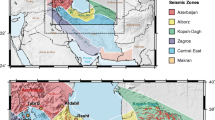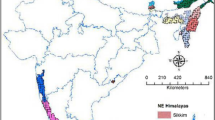Abstract
This study presents research toward the development of ground-shaking maps after a real earthquake, or for scenario earthquakes originating from seismic sources within and around the Sultanate of Oman. Major important earthquake sources that are important for the Sultanate of Oman are the Makran zone, the Zagros zone, the Zendan-Minab system, the Oman Mountain zone, the Owen fracture zone and the Gulf of Aden zone. The earthquakes that take place on these zones, particularly those from Makran, already resulted and are likely to result in ground-shaking levels that may be significant for the country. The hazard module of software package ELER was customized for use in the development of shake maps in the Sultanate of Oman. For this purpose, (1) major active faults and systems within and around Oman were defined and implemented; (2) ground-motion prediction equations suitable for use and representative of tectonic conditions in Oman were identified and implemented; (3) the effect of local site conditions in resulting ground-shaking levels was attended by implementing the Vs30 maps into ELER methodology; and (4) scripts were developed for the consideration of ground-motion data coming from strong motion stations and from seismometers in and around Oman. They were used in the adjustment of ground-motion distribution maps, such as peak ground acceleration, peak ground velocity and spectral acceleration maps produced using ground-motion prediction equations. Example runs of different scenarios reflecting the use of newly adopted information are presented.















Similar content being viewed by others
References
Abrahmson NA, Silva WJ (1997) Empirical response spectra attenuation relations for shallow crustal earthquakes. Seismol Res Lett 68:94–127
Ambraseys NN, Simpson KA, Bommer JJ (1996) The prediction of horizontal response spectra in Europe. Earthq Eng Struct Dyn 25:371–400
Atkinson GM, Boore DM (2003) Empirical ground-motion relations for subduction-zone earthquakes and their application to Cascadia and other regions. Bull Seismol Soc Am 93:1703–1729
Atkinson GM, Boore DM (2006) Earthquake ground-motion prediction equations for Eastern North America. Bull Seismol Soc Am 96:2181–2205
Boore DM, Joyner WB, Fumal TE (1997) Equations for estimating horizontal response spectra and peak accelerations from western north American earthquakes: a summary of recent work. Seismol Res Lett 68:128–153
Christensen NI, Smewing JD (1981) Geology and seismic structure of the northern section of the Oman ophiolite. J Geophys Res 86(Nb4):2545–2555
Cozzi A, Rea G, Craig J (2012) From global geology to hydrocarbon exploration: Ediacaran-Early Cambrian petroleum plays of India, Pakistan and Oman. In: Bhat G, Craig J, Thurow JW, Thusu B, Cozzi A (eds) Book Series: Geology and hydrocarbon potential of Neoproterozoic-Cambrian Basins in Asia, vol 366. Geological Society Special Publication, London, pp 131–162
DeMets C (2008) Arabia’s slow dance with India. Nat Geosci News Views Tecton 1:10–11. doi:10.1038/ngeo.2007.56
ELER v3.1 (2010) Earthquake loss estimation routine. Department of Earthquake Engineering, Bogazici University, Istanbul
El-Hussain I, Deif A, Al-Jabri K, Al-Hashmi S, Al-Toubi K, Alshijbi Y and Al-Saifi M (2010) Probabilistic and deterministic seismic hazard assessment for Sultanate of Oman. In: Project Report. Sultan Qaboos University, Earthquake Monitoring Center
El-Hussain I, Deif A, Al-Jabri K, Toksoz N, El-Hady S, Al-Hashmi S, Al-Toubi K, Al-Shijby Y, Al-Saify M, Kuleli S (2012) Probabilistic seismic hazard maps for the Sultanate of Oman. Nat Hazards 64:173–210. doi:10.1007/s11069-012-0232-3
El-Hussain I, Deif A, Al-Jabri K, Al-Hashmi, S, Al-Toubi K, Al-Shijby Y, Al-Saify M, Al-Habsi Z (2012b) Mitigation of seismic risk by microzonation Muscat Area, Sultanate of Oman, (Phase II). Project #22409017, submitted to Sultan Qaboos University, Oman
Ellison RA, Styles MT (2006) The geology and geophysics of the United Arab Emirates. Volume 1: executive summary. Keyworth, British Geological Survey
Erdik M, Sesetyan K, Demircioglu MB, Hancilar U, Zulfikar C (2011) Rapid earthquake loss assessment after damaging earthquakes. Soil Dyn Earthq Eng 31(2):247–266
Glennie KW, Boeuf MGA, Hughes Clarke MW, Moody-Stuart M, Pilaar WHF, Reinhardt BM (1974) Geology of the Oman Mountains. Verhandelingen Koninklijk Nederlands Geologisch Mijnbowkundig Genootschaap, vol 31, 423p
Hancilar, U, El-Hussain I, Sesetyan K, Deif A, Çaktı E, Al-Rawas G, Şafak E, Aljabri K (2014) Earthquake risk assessment for the building inventory of Muscat City, Sultanate of Oman, under review at Engineering Structures
Johnson PR (1998) Tectonic map of Saudi Arabia and adjacent areas. Deputy Ministry for Mineral Resources, USGS TR-98-3, Saudi Arabia
Kusky T, Robinson C, El-Baz F (2005) Tertiary–Quaternary faulting and uplift in the northern Oman Hajar Mountains. J Geol Soc 162:871–888
Lippard SJ, Smewing JD, Rothery DA, Browning P (1982) The geology of the Dibba Zone, northern Oman Mountains—a preliminary study. J Geol Soc 139:59–66
MATLAB®:R (2012) The MathWorks, Inc, Natick, MA, USA
Maurer F, Martini R, Rettori R, Hillgartner H, Cirilli S (2009) The geology of Khuff outcrop analogues in the Musandam Peninsula, United Arab Emirates and Oman. Geoarabia 14(3):125–158
Mokhtari M, Fard I, Hessami K (2008) Structural elements of the Makran region, Oman Sea and their potential relevance to tsunamigenisis. Nat Hazards 47:185–199
Pararas-Carayannis G (2004) Seismo-dynamics of compressional tectonic collision-potential for tsunami genesis along boundaries of the Indian, Eurasian and Arabian plates. In: Abstract submitted to the International Conference HAZARDS 2004, Hyderabad, India, 2–4 Dec. 2004
Regard V, Bellier, O, Thomas JC, Bourles D, Bonnet S, Abbassi MR, Braucher R, Mercier J, Shabanian E, Soleymani S, Feghhi K (2005) Cumulative right-lateral fault slip rate across the Zagros-Makran transfer zone: role of the Minab-Zendan fault system in accommodating Arabia-Eurasia convergence in southeast Iran. Geophys J Int 162(1):177–203
Styles MT, Ellison RA, Arkley SLB, Crowley Q, Farrant A, Goodenough KM, Mc Kervey JA, Pharaoh TC, Phillips ER, Schofield D, Thomas RJ (2006) The geology and geophysics of the United Arab Emirates: Volume 2: Geology, Keyworth, British Geological Survey
Wald D J, Worden B, Quitoriano V, Pankow KL (2006) ShakeMap Manual: Technical Manual, Users Guide and Software Guide. http://pubs.usgs.gov/tm/2005/12A01/
Wald D, Wald L, Worden B, Goltz J (2003). ShakeMap—a tool for earthquake response. U.S. Geological Survey Fact Sheet 087-03
Wells DL, Coppersmith J (1994) New empirical relationships among magnitude, rupture length, rupture width, rupture area and surface displacement. Bull Seismol Soc Am 84(4):974–1002
Youngs RR, Chiou SJ, Silva WJ, Humphrey JR (1997) Strong ground motion attenuation relationships for subduction zone earthquakes. Seismol Res Lett 68:58–73
Acknowledgments
The authors would like to thank the Government of Oman for its support under Project Number 22409017.
Author information
Authors and Affiliations
Corresponding author
Ethics declarations
Conflict of interest
All potential conflicts of interest are disclosed.
Human and animal rights
The work presented in this paper does not involve research involving human participants and/or animals. Consent for submission has been received from all authors.
Rights and permissions
About this article
Cite this article
Çaktı, E., El-Hussain, I., Şeşetyan, K. et al. Development of ground-shaking maps for the Sultanate of Oman. Nat Hazards 82, 1357–1373 (2016). https://doi.org/10.1007/s11069-016-2247-7
Received:
Accepted:
Published:
Issue Date:
DOI: https://doi.org/10.1007/s11069-016-2247-7




